#Octopus Cyanea
Explore tagged Tumblr posts
Text
Fish of the Day
Today's fish of the day is the day octopus!

The day octopus, also known as the big blue octopus, and scientific name Octopus cyanea is a well known Indopacific cephalopod. Found in the Indian and Pacific ocean, this octopus can be found as far North as Hawaii to as far South as the Solomon islands, and found from the Hawaiian islands to as far East as the Red Sea and East coast of Africa. These octopi in particular are known for their color changing abilities. The name big blue comes from this color changing ability in fact, as sacs of pigments under the skin can be contracted at will to better match the surrounding environment for camouflage, and courting of mates. This color changing can also be used for communication between octopi, transmitting information of predators and prey nearby.

The diet of the octopus is made up of fish, crabs, and mollusks. This octopus in particular is diurnal, spending its time awake and active during the day, as opposed to the majority of other cephalopods of which are nocturnal. Small prey is eaten immediately when hunting, but larger prey ,such as adult crabs, must be taken back to the den of the octopi. The prey taken to this den are then killed, with crabs being killed with a single venomous bite, and mollusks being killed by strategic drilling into their shells. These shells and hard carapaces are then discarded around the mouth of the den. These dens are regularly constructed and abandoned, with each octopus spending only around 35 days in each den before moving to find another. This is due to the fact that these octopi are heavily predated on by seals (especially monk seals!), whales, eels, and sharks. To protect from these predators, other than the creation and moving of dens, these octopi have the ability to squirt ink at hunters. Concealing the water so they can get away, along with rare cases of them attacking with their sharp beaks.

Breeding and reproduction can take place year round in the day octopus. Once they reach their sexual maturity, at a size of 8cm, with females larger than males, these octopi will search out another octopus. Males will mate with multiple females at a time, attempting to avoid the females cannibalistic tendencies as long as possible. After the mating however, the sucker on the male octopus begins expanding, continuing to do so as the octopi declines and eventually dies. The female however will survive a few months longer, remaining beside her eggs no matter what. She will slowly die for lack of food and exhaustion as she guards over her eggs until they hatch. These eggs hatch into planktonic larvae, which float in the current unable to swim for the first few weeks of their lives. After that they'll survive anywhere from 12-15 months, able to reach a maximum size of 22cm, and living through only one mating season.

That's the day octopus, everyone! Have a wonderful Wednesday!
#Octopus cyanea#day octopus#big blue octopus#octopus#fish of the day#aquatic biology#marine biology#animal facts#animal#animals#informative#education#aquatic#aquatic life#nature#ocean
52 notes
·
View notes
Text

OCTOPUSES PUNCHING FISH? A NEW LOOK AT INVERTEBRATE INTELLIGENCE
Collective behaviour, social interactions, and leadership in animal groups are often driven by individual differences. However, most studies focus on single-species groups, where individual variation is relatively low, with few studies focused on multispecies behaviours. A recent study has now revealed surprising social behaviour in the day octopus (Octopus cyanea). These octopuses are not solitary hunters—they collaborate with fish during hunts and, remarkably, have been observed punching their fish partners when they fall out of line.
Researchers observed these octopuses hunting cooperatively with various species of fish, including groupers and goatfish. Even more strikingly, the octopuses were seen physically punching fish that were not contributing effectively to the hunt, enforcing a form of social coordination previously undocumented in cephalopods.
This behaviour challenges traditional views of octopus sociality. Previously thought to prowl the ocean floor alone, using camouflage to ambush prey, the study indicates that the day octopus can form complex hunting partnerships with other species. The octopus does not lead these hunting groups but appears to enforce cooperation, suggesting a higher level of social interaction and intelligence than was previously understood.
These findings raise new questions about octopus cognition and social behaviour. The ability to interact in such a coordinated manner with other species indicates that octopus intelligence may share more in common with that of vertebrates than previously assumed. It also prompts further investigation into whether these behaviours are learned or innate, and how they might vary across different octopus species.
Gif: Octopus displacing fishes by punching them, by Eduardo Sampaio
Reference (Open Access): Sampaio et al. 2024. Multidimensional social influence drives leadership and composition-dependent success in octopus–fish hunting groups. Nat Ecol Evol
77 notes
·
View notes
Text

Day octopus (Octopus cyanea) ventral view portrait, Hawaii, Pacific Ocean.
Photographer: David Fleetham
#david fleetham#photographer#nature picture library#day octopus#octopus cyanea#hawaii#pacific ocean#marine#nature
34 notes
·
View notes
Text


“Makana” Day Octopus Sculpture by Sahasa [2024] Handsculpted from Polymer Clay. ~Reblogs Appreciated~ Art Shop | Etsy Shop | Social
#polymerclay#polymer_clay#sculpey#premo#art#octopus#octopus sculpture#original art#artists on tumblr#Day Octopus#Octopus Cyanea
0 notes
Text

1 note
·
View note
Text
1 note
·
View note
Note
you should totally do octopus cyanea!!

Daily Cephalopod #207
#octopus#day octopus#octopus cyanae#squid mail くコ:彡#daily cephalopod#GOOBERS!!!#cephalopod#marine life#ocean creatures#ocean critters#marine biology
186 notes
·
View notes
Text

Day Octopus (Octopus cyanea), family Octopodidae, Solomon Islands
photorgraph by David Liittschwager
#octopus#octopodidae#cephalopod#malacology#mollusk#ocean#south pacific islands#south pacific#animals#nature
195 notes
·
View notes
Text
youtube
Excerpt from this story from NBC News:
Octopuses don’t always hunt alone — but their partners aren’t who you’d expect.
A new study shows that some members of the species Octopus cyanea maraud around the seafloor in hunting groups with fish, which sometimes include several fish species at once.
The research, published in the journal Nature on Monday, even suggests that the famously intelligent animals organized the hunting groups’ decisions, including what they should prey upon.
What’s more, the researchers witnessed the cephalopod species — often called the big blue or day octopus — punching companion fish, apparently to keep them on task and contributing to the collective effort.
Octopuses have often been thought to avoid other members of their species and prowl solo using camouflage. But the study suggests that some octopuses have surprisingly rich social lives — a finding that opens a new window into the marvels of undersea life. It’s an indication that at least one octopus species has characteristics and markers of intelligence that scientists once considered common only in vertebrates.
69 notes
·
View notes
Photo

Octopus cyanea, 2019-09-28
143 notes
·
View notes
Text
Kny Mermaid Au Ramblings P4
I know more but I practically did every other well known demon slayer character in the series so I figured I'd do one last post explaining who the rest of the cast would be as mermaids. I've already done Akaza who's a Betta fish and Kaigaku who's a black electric eel. So now I'll be doing the rest of the demons and a lot of other characters. Lord have mercy for all the fish I looked up.
Remember all of the random lower moons in the ova series and Mugen train arc? Yeah. They're all minnow mers.
Now you're probably thinking Douma would be a rainbow fish right? Well I beg to differ and offer you my take. He'd definitely be a Fairy Wrasse mer.
https://www.google.com/url?sa=t&source=web&rct=j&opi=89978449&url=https://oceananimals.org/ocean-fish/wrasse-parrotfish/wrasse/fairy-wrasse/&ved=2ahUKEwjnq_PKusKGAxWMIEQIHR_jCskQr4kDegUI1AEQAA&usg=AOvVaw2YRDgIkmfKxDF7oBof4pf8

Nakime was a hard one but I think she'd be pretty as a black butterfly goldfish mer.
https://www.google.com/url?sa=t&source=web&rct=j&opi=89978449&url=https://www.petco.com/shop/en/petcostore/product/black-butterfly-goldfish-25-35-length-%2528carassius-auratus%2529&ved=2ahUKEwiQ9s_8vsKGAxXBHUQIHVDdBtsQr4kDegQIFxAA&usg=AOvVaw3BpMo0ntw0sPot4YwstgfD

Kyogai is a Black Drum mer.
https://www.google.com/url?sa=t&source=web&rct=j&opi=89978449&url=https://en.wikipedia.org/wiki/Black_drum&ved=2ahUKEwjs8fG2v8KGAxVkKEQIHZZEOY0Qr4kDegQIPRAA&usg=AOvVaw1Ip242VSs5Kmmf7IcyeJmp

Enmu is definitely an octopus mer. Specifically like the art by @cornfleaykes linked below.
https://www.tumblr.com/cornfleaykes/720378046334615552?source=share
Kokushibo and Yoriichi are the same thing being twins. Since Kokushibo is often associated with purple and Yoriichi orange, I found a fish that could match both of them. Both twins are Biota Orangetail Damselfish mers. Only Yoriichi has unusually more orange on his tail.
https://www.google.com/url?sa=t&source=web&rct=j&opi=89978449&url=https://www.algaebarn.com/shop/captive-bred/fish/biota-orangetail-damselfish-chrysiptera-cyanea/&ved=2ahUKEwiIgui4xMKGAxUzke4BHVgcABsQr4kDegQIZBAA&usg=AOvVaw30i-fXBi32NTynUJIaGegk

Daki and Gyutaro are vastly different to match their appearances. Gyutaro is a black Hagfish mer.
https://www.google.com/url?sa=t&source=web&rct=j&opi=89978449&url=https://glassvirtualzoo.wordpress.com/black-hagfish/&ved=2ahUKEwjYgdypxsKGAxXOEkQIHWhYF6kQr4kDegQIGBAA&usg=AOvVaw1uGruM_OsZQR1lXdwTSOYt

Meanwhile Daki/Ume is a Pink Dragon Siamese Fighting Fish mer because I liked how pretty and flowing the fins were and it seems to match her well.
https://www.shutterstock.com/image-photo/pink-dragon-siamese-fighting-fish-betta-384303799

Gyokko is a mutated Blue eel mer. That's it.
Hantengu was a tricky one. I know I already listed a WHOLE BUNCH of the Kny characters as Betta fishes but I'll go ahead and say that Hantengu and his clones would all be a pod of Betta fish mers related to each other because honestly Betta Fish can come in literally EVERY color. So Urami and Hantengu are black betta fish mers. Sekido is a red one. Urogi yellow. Karaku green but a lighter green than Tanjiro. Aizetsu blue. And Zohakutan is a dark purple color.
Urokodaki would be a common goldfish mer and Jigoro is like Zenitsu and Kaigaku an electric eel mer.
Hairou would be a blacktip reef shark mer.
https://www.google.com/url?sa=t&source=web&rct=j&opi=89978449&url=https://www.tetiaroasociety.org/island/fish/blacktip-reef-shark&ved=2ahUKEwjchKSFy8KGAxXz4ckDHX8GPDkQr4kDegUI6QEQAA&usg=AOvVaw36mXG9EcE-8peU273fAVTB

Muzan is a rare pitch black Bigeye Sand Tiger Shark mer like the one in the article.
https://www.newsweek.com/scientists-find-new-all-black-glowing-shark-species-ninja-lanternshark-409718
Rei and her daughter are both Brown Sweetlips mers.
https://www.google.com/url?sa=t&source=web&rct=j&opi=89978449&url=https://www.shutterstock.com/search/brown-sweetlips-fish&ved=2ahUKEwiS3POCzMKGAxWx7skDHaGFLogQr4kDegQIExAA&usg=AOvVaw3goHa1p3bOS5lBqxcq4ZAx

Haganezuka and the other sword smiths would be manta ray or sting ray mers mostly because I saw some art of Manta ray Mermaids and I think they'd look cool as them.
Rui and the rest of the spider demon are Albino Diving Bell Spider drows which turns out are a real species of spider that lives underwater.
https://www.google.com/url?sa=t&source=web&rct=j&opi=89978449&url=https://www.treehugger.com/nature-blows-my-mind-strange-scuba-diving-spider-4855467&ved=2ahUKEwjW68y8z8KGAxVKHUQIHRSQBwAQr4kDegQIExAA&usg=AOvVaw3T_2Bats74FtQgsKBBWGkX

Bonus mentions
Susamaru is an octopus mer too. Yahaba is a Cleaner fish mer. The swamp demon is just a trio of sea monsters. Tanjiro's ancestors in Yoriichi's flashbacks are Betta fish like the rest of Tanjiro's family. Tokito's father is a red herring mer. Sabito is a common orange Koi. Tengen's brother is a black butterfly koi mer. Monoko is a blue Glofish mer. And Giyuu's sister is the same species of mer as him.
Both Uta and Michikatsu's wife are both Rainbow Trout mers.
https://www.google.com/url?sa=t&source=web&rct=j&opi=89978449&url=https://www.wildtrout.org/content/rainbow-trout&ved=2ahUKEwjL2vXv0cKGAxU_GtAFHat1L9kQr4kDegQIGBAA&usg=AOvVaw1tXsb92zhaFmgDqHcmoWuo

And finally the Ubuyashikis. Amane and Their daughters are all white spotted jellyfish mers.
https://www.google.com/url?sa=t&source=web&rct=j&opi=89978449&url=https://www.crittersquad.com/fact-sheets/white-spotted-jelly-fact-sheet/&ved=2ahUKEwiY466vs8SGAxX748kDHfbqDk8Qr4kDegQIFhAA&usg=AOvVaw2_PbSrvezrdYdHFk1N7iKi

Meanwhile Kagaya and their son are water dragon hybrids.
https://www.google.com/url?sa=t&source=web&rct=j&opi=89978449&url=https://www.pinterest.com/pin/371406300502782906/&ved=2ahUKEwiyoqaDtMSGAxUJ5ckDHVROPSsQr4kDegUIygEQAA&usg=AOvVaw15b7fDD-PTuPL-qbgkndvL
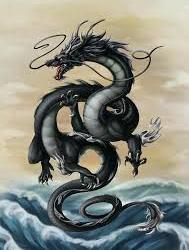
Hoo boy. That was a lot. But I'm all done now explaining who everyone is in the mer au. Honestly it was fun coming up with these.

#demon slayer#kny mermaid au#Douma#gyutaro#kny daki#Haganezuka#kny hairou#Enmu#Rui#Sabito#Uta#Kokushibo#Yoriichi#Urokodaki#jigoro kuwajima#muzan#Kny Rei#Yahaba#susamaru#kyogai#nakime#hantengu#kny urami#sekido#Karaku#aizetsu#urogi#zohakuten#gyokko#rui ayaki
39 notes
·
View notes
Text
5 instances of Tremoctopus Violaceus (common blanket octopus)
2 instances? of Mnemiopsis LeiDyi (sea walnut)
1 instance of Alitta Virens ( king rag worm)
1 instance of Trachipterus arcticus (medetarenean dealfish)
1 instance of Rossia Pacifica (stuby squid)
1 instance of Antiopella Cristatus (crested aeolis)
4 instances of Cestum Veneris (venus girdle)
1 instance of Teuthowenia Pellucida (googly-eyed glass squid)
1 instance of Periphylla Periphylla (helmet jellyfish)
1 instance of Peinaleopolynoe Orphanae (elvis worm)
1 instance of Cyanea Capillata (lions mane jellyfish)
1 instance of Tomopteris (gossamer worm)
1 instance of Sepioteuthis Lessoniana (bigfin reef squid)
1 instance of Clione Limacina (sea angle)
Regretably the third image of the post has escaped my powers.
These creatures are primarily cephalopods, and centophora.

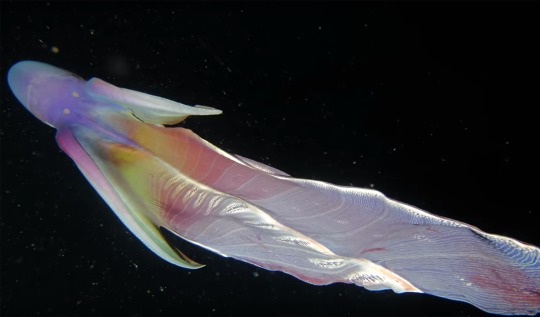
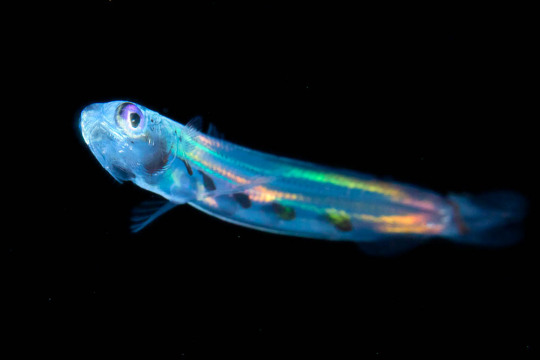
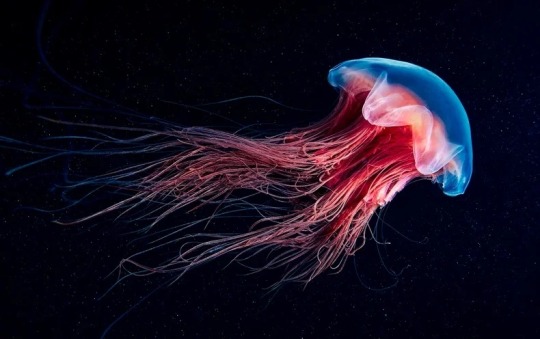
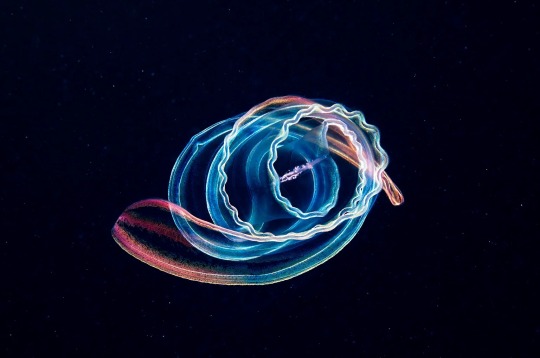

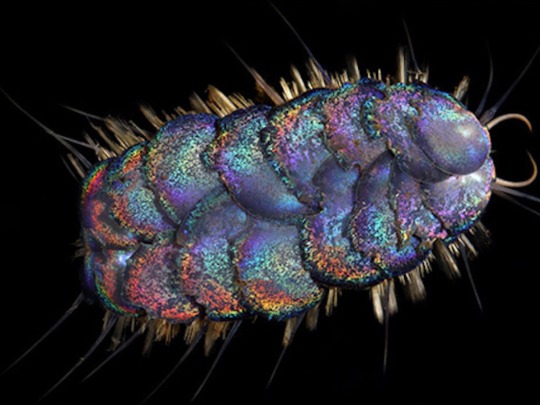
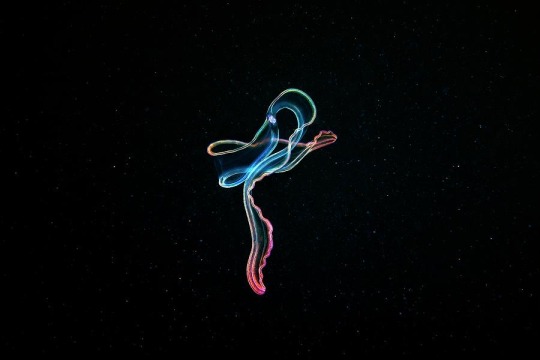

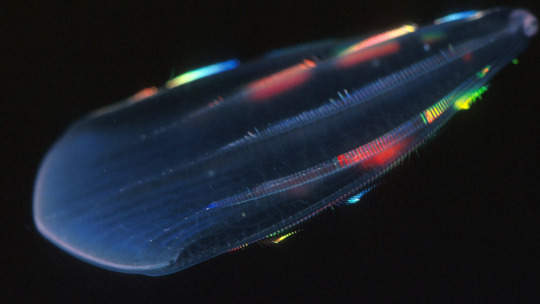


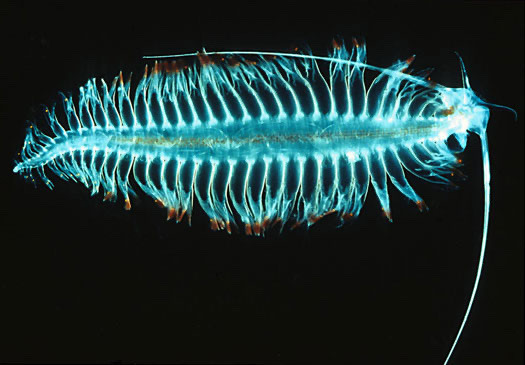
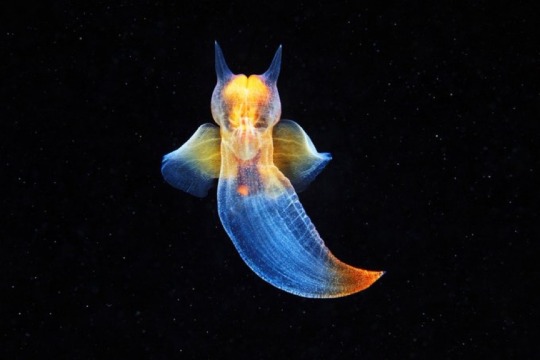
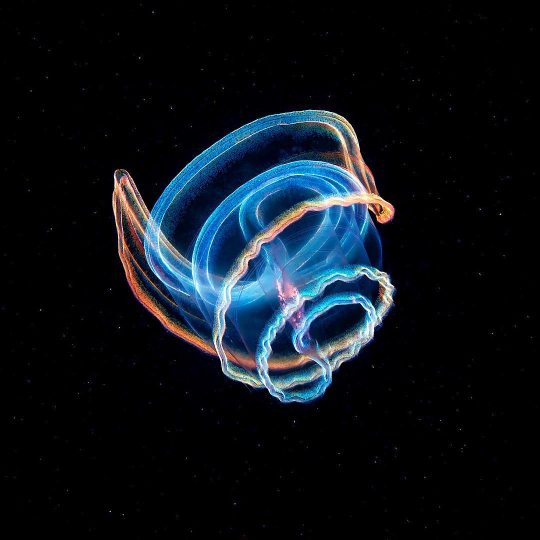
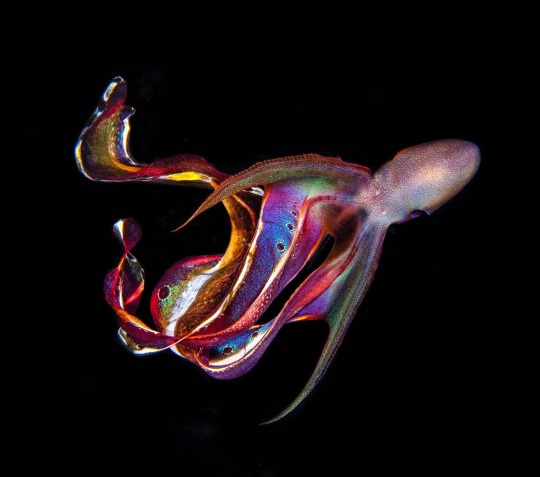
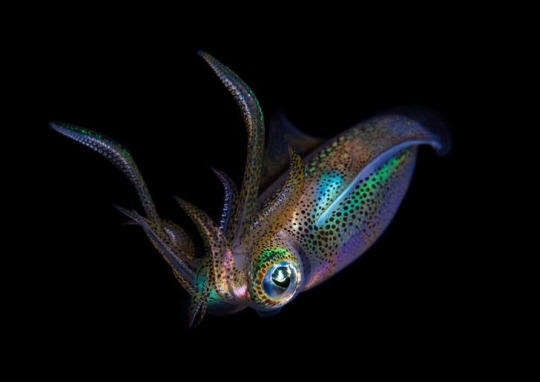
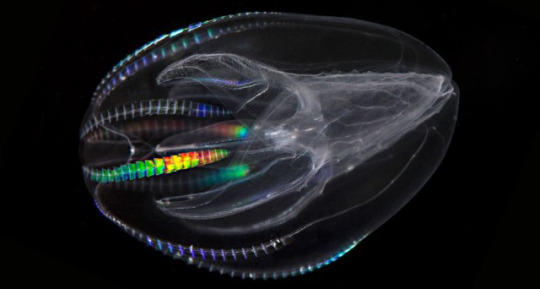

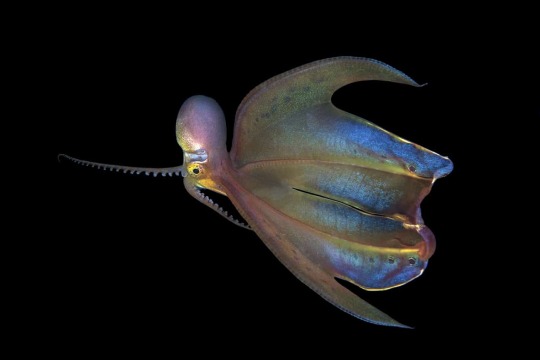
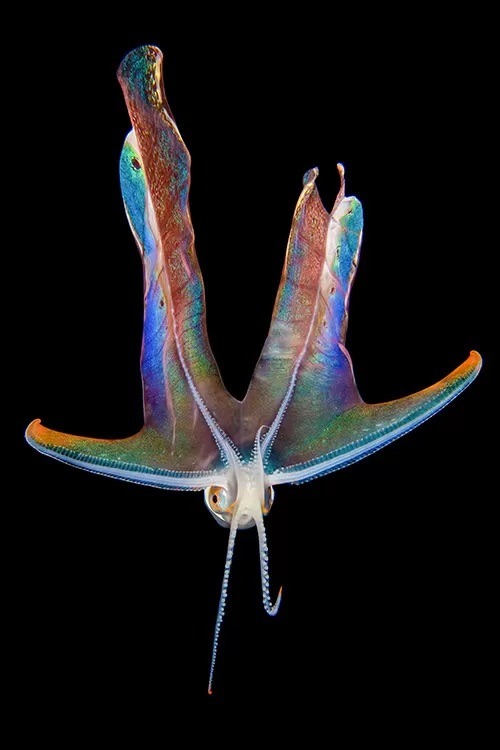
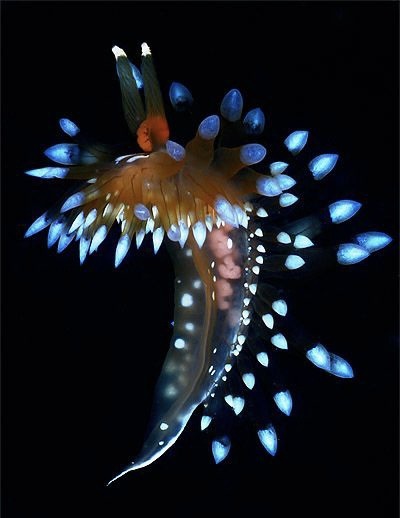

Oh to be an iridescent sea creature 💚 💙 💜
6K notes
·
View notes
Text
In the waters of the Red Sea, fish and octopuses are forming an unlikely alliance: They’re joining forces to track down prey, establishing a hunting operation that’s potentially more effective than either creature working alone.
With the octopus leading the charge, fish scout for hidden prey and signal where to capture a smaller fish or mollusk. But if freeloading fish are hovering around, looking to benefit from the hunt without contributing, the octopus punches them away, according to new research.
“The octopus basically works as the decider of the group,” Eduardo Sampaio, a researcher at the Max Planck Institute of Animal Behavior and lead author of the study, tells Nature News’ Helena Kudiabor.
The study, published on Monday in Nature Ecology & Evolution, brought a new type of collective behavior to light. Octopuses, often thought of as solitary creatures, led a group of various species of fish and discerned which ones were and weren’t helping.
“Nobody really knew that octopus have this sophisticated social life—not with other octopus, but with other species,” study co-author Iain Couzin, an evolutionary biologist and director of the Max Planck Institute of Animal Behavior, tells Popular Science’s Lauren Leffer.
Sampaio and his team collected around 120 hours of underwater footage during dives in the Red Sea. They filmed 13 scenes that showed a big blue octopus (Octopus cyanea) hunting with different fish species. And the various animals appeared to have distinct roles in the operation.
“These fish function as an extended sensory system for the octopus,” Sampaio tells Vice’s Mirjam Guesgen. “The octopus can basically sample or explore the environment just by watching them.”
One of the octopus’s biggest helpers was a species of fish called the blue goatfish (Parupeneus cyclostomus), which had strong team hunting skills. They would explore new crevices and show the octopus where to find prey by hovering over the area or moving from the crevice to the octopus and back.
“If the group is moving, everyone’s happy. It’s all good,” Sampaio tells National Geographic’s Melissa Hobson. Sometimes, other species of fish, most often blacktip groupers (Epinephelus fasciatus), weren’t as helpful and seemed to be waiting for others to do the work. In these cases, they would receive a jab from the octopus.
But it wasn’t just the octopus that was controlling members of the group—some fish would also displace others by darting toward them. Fish did not show aggressive action toward the octopus, according to the paper, suggesting the cephalopod was the dominant individual. The octopus seemed to decide whether or not the group would move to a new area.
When the hunting party identifies hidden prey beneath a rock, the octopus wraps its body around the stone, trapping the animal. This is standard hunting behavior for the big blue octopus, but when pursuing prey alongside fish, the cephalopod performs this wrapping action fewer times, the team found, presumably saving energy.
By getting deeper insights into collective animal movements, researchers can help conserve other species, says Marina Papadopoulou, a computational biologist at Swansea University in Wales who wasn’t involved in the study, to the New York Times’ Elizabeth Preston.
Still, the videos couldn’t capture whether the individuals in the hunting group remained the same. For future research, Sampaio and his team want to determine if the animals recognize each other, as it would add even more nuance and complexity to the interaction.
“Does this octopus like to hunt with blue goatfish generally, or does it really want to hunt with Martha, who is a good hunter, and not Steve, who is lazy?” he says to Popular Science.
The researchers have another gap they’ve been trying to fill: It’s difficult to determine the benefit each species is getting, or more specifically, who is eating the prey. The octopus gets the most benefit, they hypothesize, compared to hunting solo. Some fish get to make a catch if the prey escapes the octopus, per the New York Times. But they’re unsure if all fish get equal amounts.
For other scientists, like Hannah MacGregor, a marine animal-behavior researcher at the University of Cambridge in England, the work is already “really fascinating,” she tells Nature News, and it helps researchers gain a better understanding of “what would drive, in this case, groups of completely different species to stick together.”
----
0 notes
Text
Te leemos las noticias aquí Los peces actúan como un sistema sensorial ampliado para los pulpos, cubriendo zonas más extensas y mejorando la eficacia de detección de presas. / Eduardo Sampaio (Universidad de Lisboa Los investigadores realizaron 120 horas de inmersiones para observar cómo se organizaban estos animales en sus expediciones de caza conjunta. El nuevo estudio amplia la comprensión del liderazgo y la sofisticada vida social de estas criaturas marinas. Los pulpos suelen considerarse animales solitarios, sin embargo algunas especies cazan en grupo con otros peces, con los que surgen interacciones grupales más complejas que la del cefalópodo encabezando al grupo, como se creía. Un estudio que publica Nature Ecology & Evolution encabezado por Eduardo Sampaio de la Universidad de Lisboa y del Instituto Max Planck para el comportamiento animal (Alemania), indica que en esas partidas de caza mixta pulpos y peces parecen compartir el liderazgo. Observaciones anteriores sugerían que los pulpos lideraban la caza mientras que los peces normalmente los seguían, pero las observaciones realizadas por el equipo durante expediciones submarinas en el Mar Rojo indican que las interacciones grupales son más complejas. El equipo observó y documentó con 120 horas de inmersiones de 13 grupos de caza, formados por pulpos Octopus cyanea y peces como gallinetas o meros, en busca de moluscos o crustáceos, para estudiar si se establecía un liderazgo para los distintos tipos de decisiones. Roles especializados En estos grupos, la influencia social no está distribuida uniformemente, sino más bien estructurada jerárquicamente en múltiples dimensiones, lo que refleja roles especializados dentro del grupo, explicó Sampaio. Los peces, en especial la gallineta, son responsables de la exploración del entorno, dictando la dirección del grupo, mientras que el pulpo determina el momento y el inicio del movimiento de todos. Los peces actúan como un sistema sensorial ampliado para los pulpos, cubriendo zonas más extensas y mejorando la eficacia de detección de presas. Interacción beneficiosa Esta beneficiosa interacción permite a los peces capturar presas de otro modo inalcanzables y a los pulpos ahorrar energía centrándose en fuentes de alimento de alta calidad, a la vez que ejercen control y proporcionan retroalimentación dentro del grupo, “lo que pone de relieve la sofisticada dinámica de colaboración de la vida marina», destacó Sampaio. Un pulpo cyanea cazando con un pez cabra azul, mientras un mero de puntas negras está al acecho. El hocico de un pez corneta también es visible en la parte superior de la imagen. / Eduardo Sampaio (Universidad de Lisboa Sampaio indicó que aunque el Octopus cyanea es solitario, también puede exhibir una notable competencia social y flexibilidad cognitiva, adaptando su comportamiento en respuesta a las acciones de diferentes especies. Estos resultados, aseguró “amplían nuestra comprensión del liderazgo y la asocialidad, destacando la complejidad y adaptabilidad de las interacciones sociales en la naturaleza. Aunque se conocen otros tipos de manadas de caza mixtas, como tejones y coyotes, aves mixtas y morenas y meros, parecen ser menos flexibles desde el punto de vista del comportamiento a la hora de utilizar la información social para cambiar de estrategia en comparación con los grupos de caza de pulpos y peces. Referencia: Eduardo Sampaio et al. “Multidimensional social influence drives leadership and composition-dependent success in octopus–fish hunting groups”. Nature Ecology & Evolution (2024) Fuente: EFE

View On WordPress
0 notes
Text
It WAS SessionBox fucking carrd up.
Also, I'm going to make some changes to Jae's DirgeOnline verse: He is experimented on and as a result becomes able to mimic others' appearances (NOT their abilities, however), a skill he uses to get his targets in more vulnerable positions before killing them. He can also visually camouflage himself to blend in with his surroundings similar to Octopus cyanea.
1 note
·
View note
Text
Marine creatures in coral reef ecosystem

Credit: Raavya Bhattacharyya
Hi. This is the fourth entry in the series of blogs about coral reefs. In this blog, we will look at the various fantastic marine creatures in the coral reef ecosystem. More than thousands of marine life interact with coral reefs, but we will only see some of them in the blog. Let's start exploring them.
Coral-feeding fishes
In addition to shelter and living spaces, corals are the food source of coral-feeding fishes (also known as corallivorous fishes) (Cole, Pratchett & Jones 2008). Among 128 corallivorous fishes from 11 families documented, 69 belong to the family Chaetodontidae. Other families include the Balistidae, Labridae, Monacanthidae, Pomacentridae, Scaridae and Tetraodontidae. Below are examples of fish species of the mentioned families. Some are not coral-feeding fishes. The pictures just show how the species will look in a particular family.
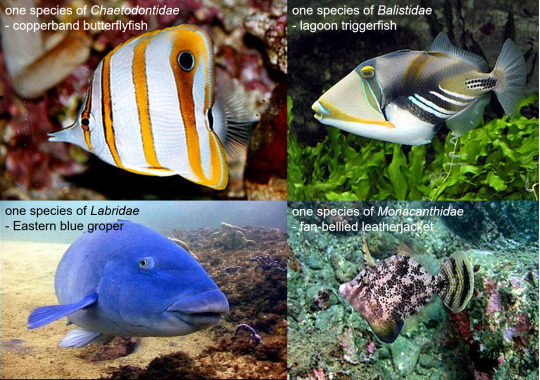

Credit: Wiktionary (Chaetodontidae); Wikipedia (Balistidae; Monacanthidae; Pomacentridae; Scaridae; Tetraodontidae); Tim Hochgrebe (Labridae).
One-third of them almost feed only on corals, which make up more than 80% of the diet. Regarding feeding preference, some ingest the live coral tissue (e.g., coral polyps, coral mucous, coral skeleton), while some prefer the dead tissue (e.g., dead coral skeletons). For instance (Cole, Pratchett & Jones 2008):
coral polyps - chevron butterflyfish, Chaetodon trifascialis, Chaetodontidae
coral mucous - ornate butterflyfish, Chaetodon ornatissimus, Chaetodontidae
live coral skeletons - guieneafowl puffer, Arothron meleagris, Tetraodontidae
dead coral skeletons - scraping scarids
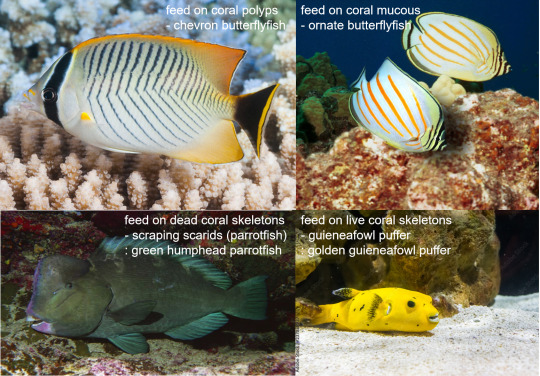
Credit: Francois Libert (chevron butterflyfish); Jim Nelson (ornate butterflyfish); Charlotte B (guieneafowl puffer); One People One Reef (scraping scarids)
This chronic predation can help regulate the abundance, distribution and fitness of some coral prey (Cox 1986; Rotjan & Lewis 2005; Rotjan et al. 2006). For instance, the selective predation of the coral-feeding fish Chaetodon unimaculatus on the corals Montipora verrucosa affects the coral growth, zonation and competitive ability (Cox 1986).
Coral groupers and trouts and their hunting partners
Coral groupers Plectropomus pessuliferus marisrubri and coral trouts Plectropomus leopardus feed on small fishes in the coral reefs (Vail, Manica & Bshary 2013). However, due to their relatively large body size, they cannot enter the coral reefs to conduct predation. Therefore, they cooperate with the hunting partners (Vail, Manica & Bshary 2013). For instance, the coral groupers Plectropomus pessuliferus marisrubri partner with the giant moray eel Gymnothorax javanicus and the Napoleon wrasse Cheilinus undulatus in predation (Bshary et al. 2006). The coral trouts Plectropomus leopardus hunt collaboratively with the octopus Octopus cyanea (Vail, Manica & Bshary 2013). The hunting partnership is beneficial as it increases the predation rate.
Collaborative hunting tactics (Bshary et al. 2006; Vail, Manica & Bshary 2013):
Coral groupers and trouts - indicate location of hidden prey in coral reefs to hunting partners and capture chased prey in open water using burst speed
Hunting partners:
Giant moray eels - have slender body to enter the coral crevices
Napoleon wrasses - have protractile jaws to suck out hidden prey or smash the reef matrix around the prey
Octopuses - have long arms to capture prey in cervices

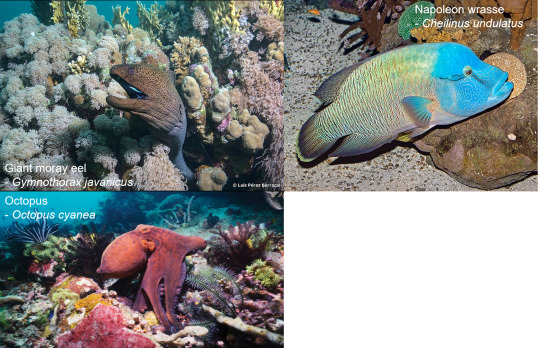
Credit: Georgette Douwma (Plectropomus pessuliferus marisrubri); Graham Edgar (Plectropomus leopardus); Luis Pérez Berrocal (Gymnothorax javanicus); Giuseppe Mazza (Cheilinus undulatus); Age Fotostock/Alamy Stock Photo (Octopus cyanea )
Flamingo tongue snail
Flamingo tongue snails (Cyphoma gibbosum) are gregarious sea snails that are found on the gorgonian corals, which possess distasteful toxins to protect them from being eaten (Whalen 2008). These tiny creatures are smaller than a postage stamp. Unlike most marine animals, they like to eat the gorgonian corals. They munch the toxin-saturated tissue until the hard skeleton of gorgonian corals using radula (modified tooth). One unique feature is that they can exploit the gorgonian toxins and incorporate them into the flaps of their brightly coloured mantle to make them awful to be eaten by fish (Whalen 2008).
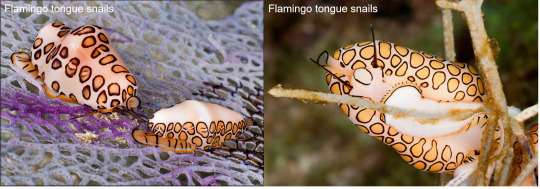
Credit: Linda Ianniello
This is the end of this blog. I hope these fantastic marine creatures in the coral reef ecosystem have amazed you.
References
Bshary, R, Hohner, A, Ait-el-Djoudi, K & Fricke, H 2006, ‘Interspecific communicative and coordinated hunting between groupers and giant moray eels in the Red Sea’, PLoS Biology, vol. 4, no. 12, p. e431.
Cole, AJ, Pratchett, MS & Jones, GP 2008, ‘Diversity and functional importance of coral‐feeding fishes on tropical coral reefs’, Fish and Fisheries, vol. 9, no. 3, pp. 286-307.
Cox, EF 1986, ‘The effects of a selective corallivore on growth rates and competition for space between two species of Hawaiian corals’, Journal of Experimental Marine Biology and Ecology, vol. 101, no. 2, pp. 161-174.
Rotjan, RD, Dimond, JL, Thornhill, DJ, Leichter, JJ, Helmuth, B, Kemp, DW & Lewis, SM 2006, ‘Chronic parrotfish grazing impedes coral recovery after bleaching’, Coral Reefs, vol. 25, pp. 361-368.
Rotjan, RD & Lewis, SM 2005, ‘Selective predation by parrotfishes on the reef coral Porites astreoides’, Marine Ecology Progress Series, vol. 305, pp. 193-201.
Vail, AL, Manica, A & Bshary, R 2013, ‘Referential gestures in fish collaborative hunting’, Nature Communications, vol. 4, no. 1, p. 1765.
Whalen, K 2008, ‘Biochemical warfare on coral reefs’, Oceanus, vol. 47, no. 1, p. 13.
Images or videos from external sources:
Age Fotostock/Alamy Stock Photo - https://www.worldwildlife.org/magazine/issues/spring-2019/articles/meet-the-master-of-camouflage-the-day-octopus
Charlotte B - https://stock.adobe.com/images/golden-guineafowl-puffer-fish-swimming-over-the-bottom-a-funny-and-venomous-tropical-fish-from-the-pacific-ocean/237039937
Francois Libert - https://uk.inaturalist.org/photos/171100563
Georgette Douwma - https://www.naturepl.com/stock-photo/red-sea-coral-grouper-%28plectropomus-pessuliferus-marisrubri%29-egypt-red-sea/search/detail-0_01448718.html
Giuseppe Mazza - https://www.monaconatureencyclopedia.com/cheilinus-undulatus/?lang=en
Graham Edgar - https://reeflifesurvey.com/species/plectropomus-leopardus/
Jim Nelson - https://www.projectnoah.org/spottings/2050146002
Linda Ianniello
- https://www.jaxshells.org/ryxx.htm
- https://www.jaxshells.org/6016.htm
Luis Pérez Berrocal - https://www.inaturalist.org/taxa/121000-Gymnothorax-javanicus
One People One Reef - https://onepeopleonereef.org/resources/fish-info/herbivorous-fishes/parrotfishes-scarids/
Raavya Bhattacharyya - https://travel.earth/best-coral-reefs-across-the-world/
Tim Hochgrebe - https://australian.museum/learn/animals/fishes/labridae-wrasses/
Wikipedia
- https://en.wikipedia.org/wiki/Filefish
- https://en.wikipedia.org/wiki/Parrotfish
- https://en.wikipedia.org/wiki/Pomacentridae
- https://en.wikipedia.org/wiki/Tetraodontidae
- https://en.wikipedia.org/wiki/Triggerfish
Wiktionary - https://en.wiktionary.org/wiki/butterflyfish
1 note
·
View note